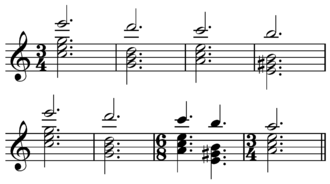
Back Romanesca German Romanesca Estonian Romanesca French רומנסקה HE Romanesca (musica) Italian Romanesca NB Романеска Russian 羅曼尼斯卡 Chinese


Romanesca is a melodic-harmonic formula popular from the mid–16th to early–17th centuries that was used as an aria formula for singing poetry and as a subject for instrumental variation. The pattern, which is found in an endless collection of compositions labeled romanesca, perhaps named after the Roma, is a descending descant formula within a chordal progression that has a bass which moves by 4ths. The formula was not to be viewed as a fixed tune, but as a framework over which elaborate ornamentation can occur.[3] It was most popular with Italian and Spanish composers of the Renaissance and early Baroque period. It was also used by vihuelistas including Luis de Narváez, Alonso Mudarra, Enríquez de Valderrábano, and Diego Pisador.[1]
- ^ a b Cite error: The named reference
Guitarwas invoked but never defined (see the help page). - ^ Cite error: The named reference
Apelwas invoked but never defined (see the help page). - ^ Gerbino, Giuseppe. (2001). Romanesca. In John Tyrrell and Stanley Sadie (Eds.), The New Grove Dictionary of music and musicians (2nd ed., Vol. 21, pp. 577-578). New York: Grove
© MMXXIII Rich X Search. We shall prevail. All rights reserved. Rich X Search